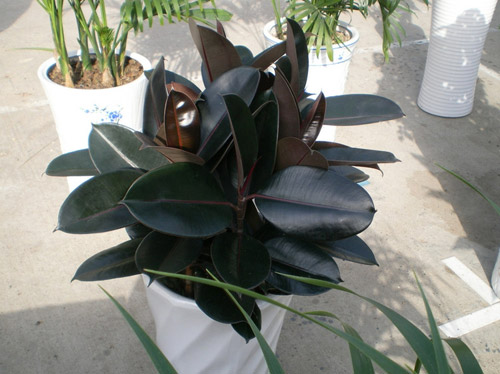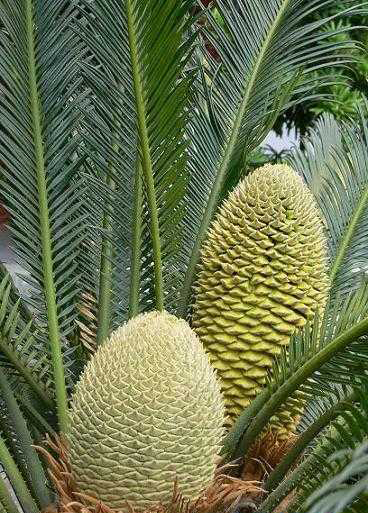How should potted rubber trees be maintained?
When planting rubber trees in pots, one part of rotten leaf soil, one part of garden soil and one part of river sandy soil should be used, and a small amount of base fertilizer should be added to form culture soil. It grows very fast in a hot and humid environment, producing a leaf every 5 to 10 days. During this period, we must ensure adequate fertilizer and moisture, apply liquid fertilizer or compound fertilizer once or twice a month, while maintaining high soil moisture. After autumn, gradually reduce the number of fertilization and watering, in order to promote plant growth and enrichment, conducive to overwintering.
Rubber trees like strong light and should be cultivated in the sun throughout the growing season from spring to autumn and in strong light in winter, but it can also tolerate shade and is better cultivated in low light indoors. In addition, in order to make the plant grow symmetrically and ensure a good plant type, the heart should be removed when the seedlings grow to 50-80 cm high, so as to promote the germination of the side; only 3-5 branches are selected after the side grows, and the rest are thinned, and then the lateral branches are cut once a year, and the larger plants with complete plant type and full circle can be obtained after 2-3 years.

Rubber tree, also known as Indian yong, Indian rubber tree, is an evergreen tree of Moraceae. The leaves are beautiful and glossy, and they are famous potted foliage plants.
Rubber tree is native to India and Malaysia, and now it is cultivated in many parts of our country. Sex likes a warm, humid, sunny environment, but also slightly shade-resistant, not cold-resistant. It is required to have fertile and loose soil and grow well in neutral or acidic soil. When potted, it is appropriate to use rotten leaf soil, grass ash soil plus about 1 to 4 river sand and a small amount of base fertilizer to form culture soil. Usually keep the soil moist and apply dilute liquid fertilizer every 15-20 days. High temperature in summer, rubber trees grow faster, should be fat and water, but to avoid stagnant water in the basin. After entering autumn, fertilization and watering are gradually reduced to promote plant growth and enrichment, which is conducive to overwintering. Because rubber trees like the sun, they should be kept outside in the sun from spring to autumn; if placed in a shaded place for a long time, it is easy to cause leaves to yellowing and falling off.
Because the rubber tree is not resistant to cold, it must be moved to the sunny place indoors for maintenance in winter, keeping the room temperature above 10 ℃, and the minimum temperature not lower than 5 ℃; if the temperature is too low and the basin soil is wet, it will cause the leaves to blacken and fall off and the roots to rot, or even the whole plant to die. Move to the courtyard or balcony for maintenance from the end of April to the beginning of May next year.
After potted rubber trees become seedlings, it is appropriate to turn the pot and change the soil every year before the new buds grow in spring. When turning the basin, cut off the curled root system properly and add new culture soil and base fertilizer. For overgrown plants, you can also change to a larger flowerpot in September. In order to make the plant shape of potted rubber trees plump, coring should be carried out when the seedlings grow to 60-80 cm high, in order to promote lateral bud germination. After the lateral branches grow, choose 3-5, and then cut the opposite lateral branches once a year, and you can get round and plump trees 1.5-2 meters high in 3 years.
Four seasons conservation of rubber tree potted plants in spring
The rubber tree is strong by nature and easy to manage. Put the plant in a bright place in spring, keep the basin soil moist, and often sprinkle water around the plant to increase air humidity. Fertilize properly according to the growth status of the plant. When the temperature rises gradually at the end of spring, the rubber tree can be moved to a half-light environment or indoor maintenance with scattered light.
Change the basin when the temperature is about 15 ℃ in spring every year, and trim it properly before changing it.
Summer maintenance
Rubber trees are resistant to high temperature and hot sun, but too much light will also make the leaves lose their luster, which is not conducive to ornamental. The rubber tree can be placed in a bright light, or directly exposed to the sun, but with proper shade at noon.
The rubber tree has many and large leaves, large water consumption and rapid evaporation in summer, so it should be watered in time to keep the soil moist, and spray more to its leaves and surroundings to meet its requirements for air humidity.
Autumn maintenance
As the light weakens in autumn, the rubber tree can be moved to the windowsill or balcony with sufficient light to keep the basin soil moist.
To properly enhance its cold resistance in autumn, it can be exercised in outdoor low temperature for a period of time, but it can not be hit by frost. People should move indoor with light in time before frosting.
Winter maintenance
The rubber tree is not cold-resistant and can withstand a low temperature of 0 ℃ for a short time. But the indoor temperature should be kept at about 5 ℃, when the growth of rubber tree is stagnant, sufficient light should be ensured to make the basin soil moist and dry, and the basin soil is too wet and easy to rot roots. When the temperature is high at noon, spray water and spray on its surrounding and leaves for several times.
In winter, the rubber tree can grow normally when the indoor temperature is above 15 ℃, and its management is about the same as that in spring.
More rubber tree content, all in the four Seasons Plant Network!
- Prev

How to water the azaleas?
As the root system of rhododendron is shallow root slender root group, both afraid of drought and waterlogging, improper watering, light deciduous, heavy death. Therefore, proper watering is the key to the cultivation of azaleas. Watering azaleas should depend on plant growth and weather changes. Spring budding and flowering
- Next

How to cultivate multi-headed cycads?
Cycads are evergreen all the year round, with beautiful and strange plant types and leaves, long viewing period and extensive management, so they are deeply loved by conservation enthusiasts. Cycads can be placed outdoors or used for indoor viewing. If one-headed cycads can be cultivated into multi-headed cycads, the ornamental value will be even higher.
Related
- Fuxing push coffee new agricultural production and marketing class: lack of small-scale processing plants
- Jujube rice field leisure farm deep ploughing Yilan for five years to create a space for organic food and play
- Nongyu Farm-A trial of organic papaya for brave women with advanced technology
- Four points for attention in the prevention and control of diseases and insect pests of edible fungi
- How to add nutrient solution to Edible Fungi
- Is there any good way to control edible fungus mites?
- Open Inoculation Technology of Edible Fungi
- Is there any clever way to use fertilizer for edible fungus in winter?
- What agents are used to kill the pathogens of edible fungi in the mushroom shed?
- Rapid drying of Edible Fungi

